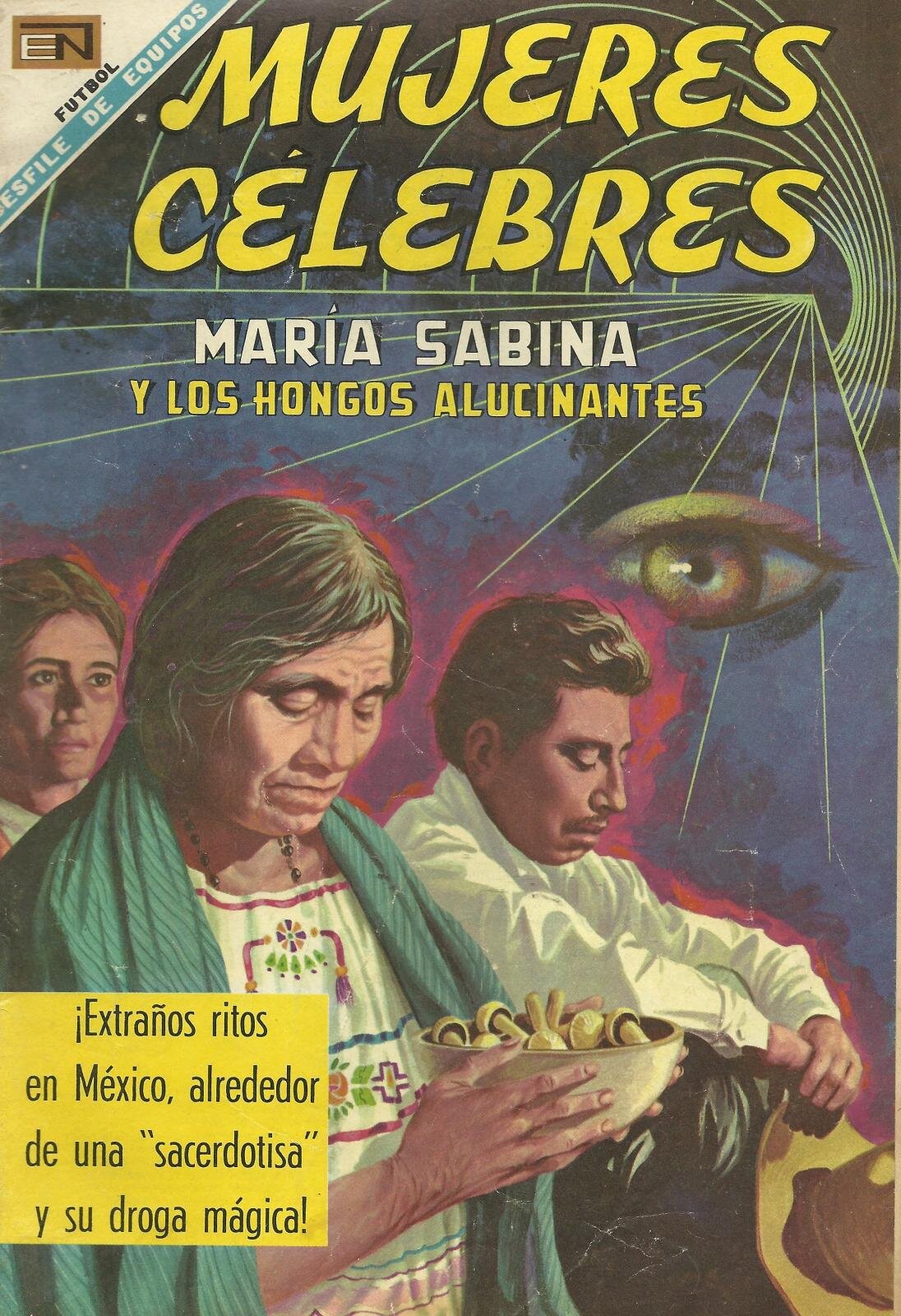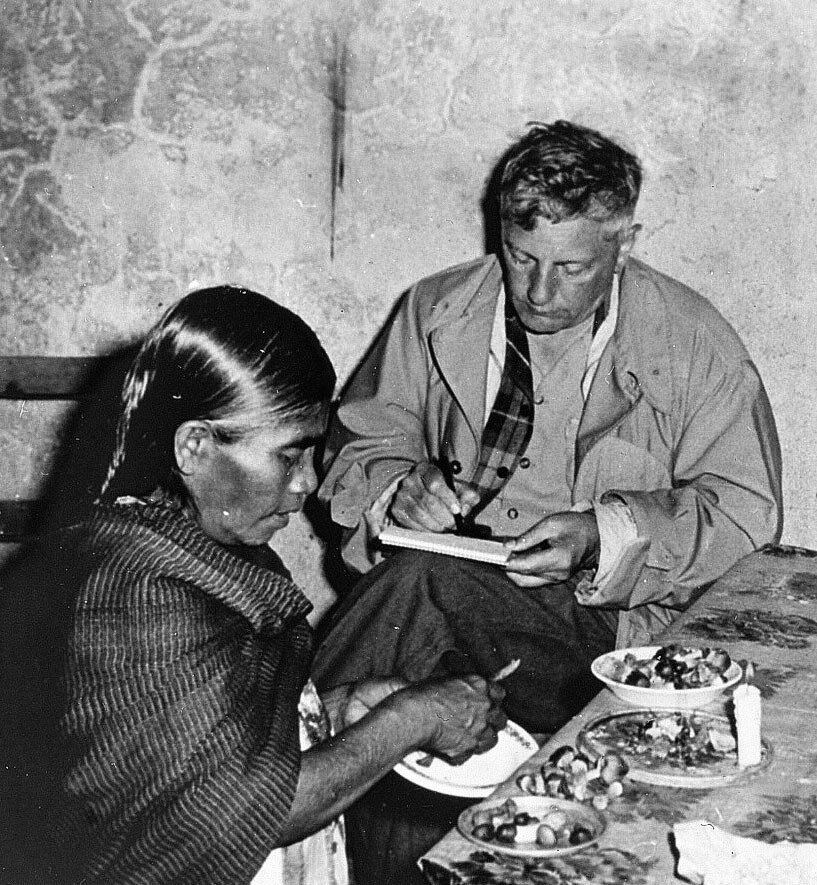Maria Sabina and the holy children
She called them the “holy children” and through them she helped heal the souls of her people. Maria Sabina Magdalena Garcia, popularly known as Maria Sabina, was a Mazatec “curandera (shaman) de primera categoria (of highest quality)” from Huautla de Jimenez, a town located in the Sierra Mazateca in the Mexican state of Oaxaca. Her paternal grandfather and great-grandfather were also shamans and she was exposed to the ceremonies from a very young age, with her first experiences starting as early as 7 years old. Kept away from the rest of the world, in a town where Spanish was not even spoken yet, Maria officiated these traditional, elaborate, healing ceremonies which she called veladas . These veladas always took place at night and they centered around the use of psilocybin mushrooms, which grew abundantly during the rainy seasons. These mushrooms were the holy children, the saint children, that guided Sabina through her ceremonies. It was the belief of the indigenous peoples that the mushrooms spoke through the shamans, allowing them to find answers to the ailments of the people who sought to be cured, if they could be cured. As such, the mushrooms were treated with respect and were considered sacred often regarded as a portal, a way to connect with God.
Maria Sabina became a controversial figure after she was catapulted to mainstream by amateur mycologist and banker, R. Gordon Wasson. In 1957, after spending four summers in the remote mountains of Mexico on a quest to find hallucinogenic mushrooms and insight into their use by indigenous people, R. Gordon Wasson, a V.P. of J.P. Morgan & Co. Inc published an article in Lifetime magazine entitled “Seeking the Magic Mushroom.” Thereby coining the now popular term “magic mushroom.” In it he writes about the fateful night he and his friend Allen Richardson , New York society photographer, became in Wasson’s words: “the first white men in recorded history to eat the divine mushrooms, which for centuries [had] been a secret of certain Indian peoples…in southern Mexico.” On that night of June 29th, 1955, Wasson and Richardson attended a rite led by two Mazatec curanderas (shamans), a mother and daughter. In an effort to conceal her identity, Wasson referred to the mother as Eva Mendez throughout the piece, which included pictures of her. The curandera was introduced to mainstream as a result of his writings and soon after people from around the world (reportedly including Bob Dylan, Peter Townsend, John Lennon, and Timothy Leary) began showing up at her Mazatec village in Oaxaca in search of Maria Sabina and her Mexican magic mushrooms.
With the onslaught of new visitors who did not come with the same respect and admiration as Wasson did, Sabina’s people became resentful of her and all the attention she was bringing to their village. Local police began to suspect she was a drug dealer ignorant of the customs long held by the Mazatec peoples and the sacred mushrooms. The constant visitors looking for nothing more than a “trip” and its hallucinations eventually led Sabina to regret ever sharing her valued traditions. She stated that “Before Wasson, nobody took the children simply to find God. They were always taken to cure the sick.”
These young people, blonde and dark-skinned, didn’t respect our customs. Never, as far as I remember, were the saint children eaten with such a lack of respect. For me it is not fun to do vigils. Whoever does it simply to feel the effects can go crazy and stay that way temporarily. Our ancestors always took the saint children at a vigil presided over by a Wise One.
Where the mushrooms once grew in abundance, the unquenchable hunger of the Westerners led to a shortage, threatening to end this Mazatec tradition. Her people began to consider her a Malinche of sorts. They burned her home down and killed her son. Their anger should have instead been directed at the man who led Wasson to Sabina in the first place. In his article Wasson explains that when he arrived to the town, unsure of where to find the mushrooms he was looking for, he went to the town hall and approached the official in charge, who he referred to as Filemon in his article. Wasson asked Filemon: "Will you…help me learn the secrets of the ‘nti sheeto’ (divine mushroom)?" Filemon was quick to lead Wasson to his own home and down to an area where the mushrooms grew so that Wasson could gather as much as he wanted. It is through this official that Wasson met Sabina. After arriving to Sabina’s daughter’s home at the direction of Filemon, Wasson asked through an interpreter if Sabina would officiate a ceremony for Wasson and his friend which Sabina agreed to.
Sabina did not consider herself a gatekeeper, it was not her decision who should have access to this divine wisdom. Wasson wrote that he was treated in a very friendly manner by the natives. He and his friend were not treated “stiffly, as strange white men; [they] were of their number.” That night in the adobe-walled home of Sabina’s daughter, we are able to witness through Wasson’s account, this ancient communion and the manner in which it is carried out. We learned that before the mushrooms are served, chocolate is drunk. We learn that Sabina cleaned the mushrooms and passed them through the smoke of copal incense while stating her pure intentions. She passed the mushrooms out in pairs, that night taking 13 pairs herself and handing six pair to Wasson and Richardson. They chewed and ingested the bad tasting mushrooms and awaited for the gates of their minds to be open. They remained in the dark the rest of the night, laying and wrapped in blankets, more awake than ever before. As they began to experience visions, the very concept of time dissipated. Their senses where heightened. They traveled through gardens, mountains, and rivers. They contemplated the very idea of God as they experienced wonder and analyzed with reason simultaneously. All the while Sabina was humming and soon began chanting in her native language. She sang in a way that was “indescribably tender and moving, fresh, vibrant, rich.” Through the mushrooms, Sabina whom Wasson referred to as Senora began to “fling forth spoken words, violent, hot, crisp words that cut the darkness like a knife. This was the mushroom speaking through her, God's words, as the Indians believe, answering the problems that had been posed by the participants.. This was the Oracle.” Sabina would take breaks every half hour or so where she would relax perhaps light a cigarette. And then she would continue, in the darkness, dancing, clapping with her sounds “coming from an unpredictable direction and distance, now close to [their] ears, now distant, above, below, here and yonder, like Hamlet's ghost hic et ubique. [They} were amazed and spellbound.” Wasson described how the mushrooms were “regarded by everyone respectfully but without solemnity… [they were] sacred and never the butt of the vulgar jocularity that is often the way of white men with alcohol.”
Wasson maintained that his research and publication of his writings was for the purpose of adding to the knowledge of mankind. However, it is believed that he was “funded by the CIA’s mind control project, MK Ultra.” He was also an investment banker and “in the early 1950s, investments in the new pharmacopeia that was emerged from experimental chemistry in the 1930s and during World War II — especially those related to treatment of mental illness — offered massive financial returns.” He took with him samples of the Mexican mushrooms, spores, and provided them to the Swiss Laboratories of Albert Hoffman, who accidentally synthesized LSD in 1937. Hoffman was able to identify psilocybin as the psychoactive ingredient within the mushrooms. During this time, psilocybin proved effective as a treatment for anxiety and other psychiatric disorders but were shelved when other “laboratory-created compounds, like Ritalin and Thorazine, proved more profitable.” After this encounter with Wasson and the negative attention that the town received, the Mexican Army “blocked American, European and Mexican hippies or other unwanted visitors from entering on the only roads into the town” and from 1967 to 1977 the town of Huautla de Jimenez was able to regain a sense of normalcy. Sabina died of malnutrition and she remained poor even after being accused of profiting from Mazatec traditions, gaining worldwide recognition, and sharing her wisdom with whoever sought her knowledge.
Maria Sabina is now resurfacing into the mainstream once more. As psychedelics are finding their way back into the popular culture, her story is being shared but not enough focus is placed on her veladas. Magic mushrooms have received a bad reputation as a party drug with many carelessly using them just to experience hallucinations without any respect for their healing properties. However, studies are proving again just how effective they can be in treating PTSD, anxiety, and medication resistant depression. Something indigenous people the world over have known for centuries. Maria Sabina’s way can be described as the right way to use these divine mushrooms as medicine, a way which is now being adopted by states like Oregon. When done the Mazateca way of “combining the drug treatment with communal support and rituals… ‘group therapy’ and ‘facilitated care’ to put in terms insurance and pharmaceutical companies can understand” we can truly witness the magic of the healing of the soul achieved through this psychotherapy. While Wasson brought tragedy to her life, he also preserved her traditions. Maria Sabina was a shaman, a poet, a healer but she never took credit for her abilities. Even in her poetry she always credited the holy children. She often ended her lines with “says” indicating that the divine mushrooms spoke through her.
I am a shooting star woman, says
I am a trumpet woman, says
I am a drum woman, says
I am a woman violinist, says
Because I am a woman of letters, says
Because I am a Book woman, says
So when you take these magic mushrooms, these holy children, remember Maria Sabina. Remember the Mazateca way. Set your intentions, respect their powerful abilities, and let the mushrooms guide your journey towards healing.
CHANTING early in the night, Maria Sabina lists her qualifications: "Am I not good? I am a creator woman, a star woman, a moon woman, a cross woman, a woman of heaven. I am a cloud person, a dew-on-the-grass person."







